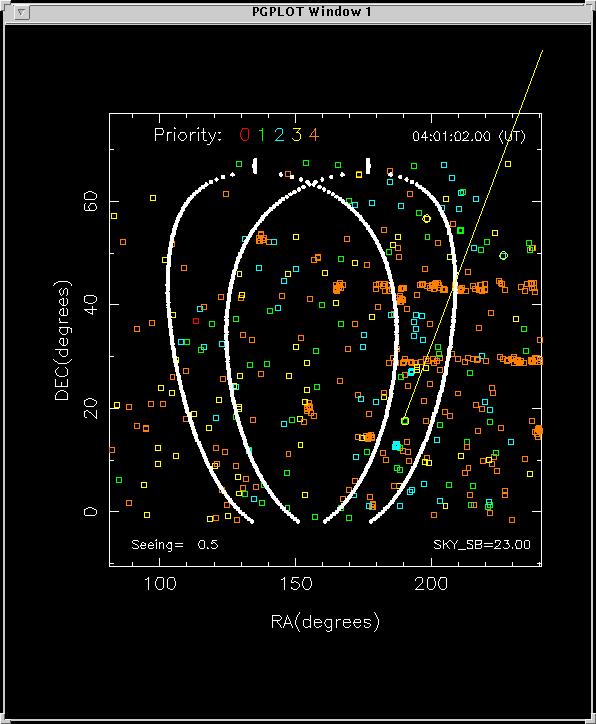SCOTOPX
Notes on SCOTOPX
One of the first things I heard upon arriving here at HET
is that numerous folks want to see an improved/graphical version
of the target selection code called htopx. We've begun assembling
bits and pieces of software to investigate how feasible a new,
or supplementary, system may be. My own exploits in this area
are contained in a software package currently on Mcs (Solaris)
called SCOTOPX.
A variety of tasks can be performed with SCOTOPX. The current
options are shown below. An example of one commonly used task
(graphical target display, option 5) is shown in Figure 1.
Many of the tasks performed by SCOTOPX are self-explanatory,
others are obscure and rarely used. One of the primary reasons
for building this code is to allow the Resident Astronomer
an easy way to query and edit the HET
observing list (plan.db).
Available tasks (as of Sep2004):
1) Interactively query the database.
2) Survey the database by column (quantity) value.
3) Edit plan.db entries one field at a time.
4) Edit plan.db in a fully general way.
5) Interactive graphical query of target list.
6) Find all unique instrument configurations.
7) Summarize the status of a program.
8) Obtain current time information.
9) Reconstruct plan.db (after file loss/damage).

|
|
Figure 1: A typical SCOTOPX display. Each target is color-coded
according to priority. The white line is connected to a point
(encased in yellow circle) that the user has selected by clicking
the middle mouse button. An instantaneous listing of the target
database entries for this source is displayed in the xterm from
which SCOTOPX is run. Cursor options allow the user to zoom into
various areas of the sky. The HET tracks are painted as a series
of white square symbols, and are updated for the current UT time
(upper right) when the screen is repainted. With a cursor command,
the user can set seeing and sky brightness cut-offs (lower-left
and lower-right) to isolate targets that are appropriate for the
conditions of the night.
|
To Be Done
1) Assign dynamic priority values based on the original
TAC grade and other properties like availability during
remainder of the trimester, tightness of seeing/sky
brightness condition, complexity of set-up, etc...
2) Ability to dump updated plan.[db,log] files with
updated number of visits, program status, etc...
3) Isolate targets by program/institution/instrument.
4) Add socket programming to allow RA,DEC of selected
targets to be sent directly to TCS.
5) Plot current position of moon. Indicate astronomical
twilight and sunrise times.
6) Add integration time "bars" on each target symbol to
allow RA to easily judge how feasible it is to complete
targets already in a track.
Back to OBSTOOLS Page
